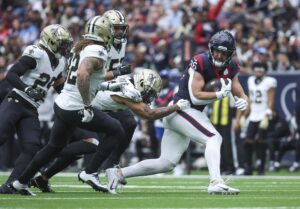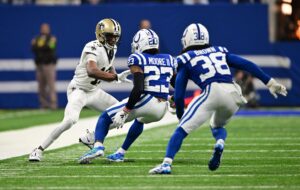Working into the next phase of our newest series “The Breakdown,” we take a look at what the Indianapolis Colts do on both sides of the ball.
The Breakdown: A Look at the Indianapolis Colts Schematic Philosophy
Relying on Heavy Formations
Quarterback Andrew Luck has oddly been a polarizing player since his 2012 NFL debut, He’s often criticized for his number of interceptions despite both his porous offensive line and high-volume, downfield system that I will delve into a little later.
Since Luck’s entrance into the league, the Colts have worked to surround him with a proper supporting cast. But receivers Donte Moncrief and Phillip Dorsett have to become the caliber of player Indy has desired, while the offensive line has been shuffled and reshuffled over the last five seasons in an attempt to find continuity. Because the Colts employ a heavy dosage of five- and seven-step drops that attack the intermediate and deep levels of the field, routes naturally need more time to develop. Defenses capitalized on this by sending long stunts and twists and late blitzes that exposed the line’s inability to recognize and adjust to these free rushers.
This passing game suited Luck well because of his level of football intelligence and pocket maneuverability as passing concepts worked late into the down. A deep-dropback passing game marries their desire to use two tight ends directly next to one another along the line of scrimmage while keeping two receivers on the opposite side, thus known as 2×2 closed. Doing so stresses the defense’s leverage principles against man and pairs with the Colts’ power running game. An extra tight end is often brought in to pass protect for these longer-developing routes, while the addition of another tight end creates a heavier run formation.
No longer having Dwayne Allen and Coby Fleener is proving to be problematic when considering the aforementioned reliance on the two-tight end sets. Both were reliable blockers and flexible pass catchers that the Colts ran a number of passing concepts through. The two could also be flexed out into the slot or sent in pre-snap motion to gain leverage advantages as receivers. What’s more, the Colts were forced to employ a number of tight formations and reduced splits to compensate for their receiving corps’ inability to effectively defeat press coverage on a consistent basis.
Finding Their Footing
It’s certainly no secret that the Colts have struggled on defense over the years-another catalyst for Luck’s struggles-and it’s time they put the pieces together once and for all.
Operating from a base 3-4, the Colts brought in former New York Giant nose tackle Johnathan Hankins, a skilled run-stuffer who will be tasked with clogging interior running lanes and generating equal pressure up the middle. Despite also adding Margus Hunt, the former Cincinnati Bengals defensive end who is better-suited for the Colts’ 3-4, they are still missing a dominant edge rusher. The additions of SAM linebacker Jabaal Sheard (New England Patriots) and rush linebacker Tarell Basham (third round draft pick in 2017) are, however, steps in the right direction.
Head coach Chuck Pagano and defensive coordinator Ted Monachino incorporate a load of designed blitzes tied in with matchup based coverage that asks much of their linebackers and safeties, two positions that Indy has struggled mightily to generate production. With their level of Cover 1 and Cover 3 usage, the addition of safety first rounder Malik Hooker provides the Colts with a rangy centerfielder. Grabbing corner Quincy Wilson in the second suggests they intend to maintain their heavy dosage of press-man. Hooker will prove to be an asset in press as well with his sideline-to-sideline coverage abilities and top-end speed to drive to the deep portions of the field.
Because it’s safe to assume the Colts’ use of man, expect them to become creative and reliant on their blitzes and stunts if their preexisting struggles with generating pressure via four-man rushes persist. Drafting linebacker Anthony Walker in the fifth round is a potential solution to this dilemma. And pairing him with Antonio Morrison in the right packages is a potentially lethal move when you consider the Colts’ desire to generate interior pressure with their inside ‘backers.






